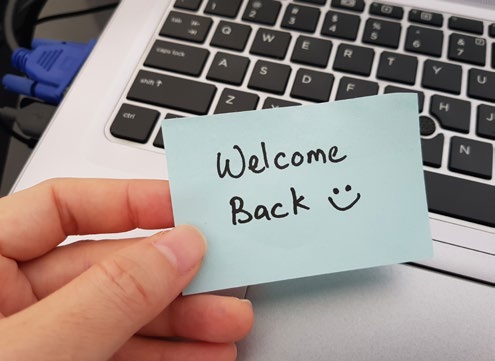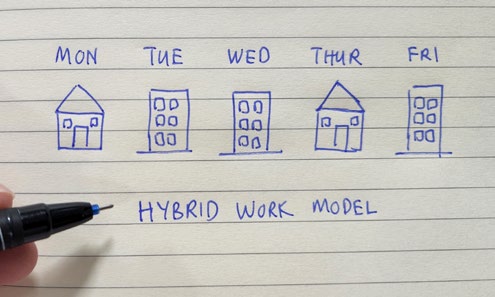
ORIGINALLY PUBLISHED BY The Source – powered by CoreNet Global
March 2023
Rakesh Kishan is managing principal of Trascent. He was interviewed at the recent CoreNet Global Summit in Chicago.
The Source: I’d like to ask you about one of the pressing topics facing corporate real estate (CRE) today, and one that’s been discussed a lot: hybrid work. What’s your take on hybrid work? Is it just a passing fad, a blip on the screen? Or does it mark a permanent change in corporations’ workplace strategies?
Rakesh: As far as I can see, and I think especially for the next five years, hybrid work is here to stay. But the world is moving rapidly. What’s going to happen after that is difficult to predict with certainty. For the midterm, absolutely it’s here to stay.

But it’s important to understand that hybrid work is also creating tension within organizations. Recently, the CEO of Microsoft, Satya Nadella, said, “80 percent of the employees we survey are saying they’re as productive if not more productive working from home.” But he also said the problem is that when we surveyed their managers, more than 80 percent said they’re less productive. So, there is a dynamic within corporations where leaders and managers are pushing employees to come back to the office, and many of the employees feel it is at their discretion if they elect to do so. This is causing the tension. Some companies are pushing for their employees to come back to the office full time. Apple did that in the beginning, and then it backed off. So that is a dynamic that’s going on.
Another contributor to that dynamic is that it is an employee’s market today. There’s not enough talent.
There is tightness in the labor market. People can pick and choose where they want to work, how they
want to work. The balance of power has really shifted to the employees, and companies are redesigning
the workplace to make it more inviting, much more collaborative, to entice them to come back.
And the third one: It’s a financial issue for many companies. For those corporations who had built
billion-dollar campuses, and these campuses are only a third occupied, it’s a financial implication for them. They are going to be pushing their employees to utilize that empty space, that very costly empty space, in tier-one markets.
The balance of power has really shifted to the employees, and companies are redesigning the workplace to make it more inviting, much more collaborative, to entice them to come back.
Given all of that, I think employees have had three years to structure their lives around working from home. Three years. It only takes a month to build a new habit; they’ve built this habit over a period of three years. It’s going to be very difficult for them to give that up and come back and face the commuting challenge and everything else and come back to the office. In the next five years, it’s here to stay unless those habits are restructured to what they were prior to COVID.
It’ll be interesting to see. There’s talk of recession on the horizon, and how that shifts the balance of power between the employee and employer. That could also affect the outcome.
The Source: Getting employees back into the office has been an aim of most corporate real estate organizations over the past year. Do you have any success stories to share – examples of companies that have been able to get office occupancy up closer to pre-pandemic levels and get more employees back into the office? If so, how did they do it?

Rakesh: It’s a combination of factors. There’s no silver bullet here. There are a number of steps companies
are taking to coax the employees back into the office. It’s really a question of coaxing. And that’s why we’re seeing the workplace being redefined.
Employees don’t want to come back to the cubicle farms of yesterday. They want to come back to a new,
more exciting, high-energy, collaborative workplace of tomorrow – the future workplace. They are not interested in coming back to what they left. They’re interested in coming back to something that will
actually add value.
Employees are recognizing that a workplace is not just a place to sit down and do work. It’s an important place in the sense that relationships are built there. And in large, matrix organizations, these organizations we are very familiar with, you need relationships to get work done. Skills and knowledge are transferred not on Zoom calls, but by working side by side.
I would say that our observation is most of our clients are pushing for a partial return to the office. They’re not really pushing for five days a week in the office. And whether it’s three days or four days, the actual attendance typically is a day less – it’s just two days in practice when it’s supposed to be three days, or three days when it’s supposed to be four. But employers don’t have a way to assess that. They also don’t have a way to enforce that policy. They’re kind of grappling with what to do. And until they answer those questions, I think attendance will be sparse, no matter what policy employers have in place. But the more inviting, the more engaging the workplace, the higher likelihood employees will come back to the office.
The Source: One of the outcomes of so many people working remotely is that there’s a lot of underutilized office space out there. How are companies reacting to this? Are they hanging on to that space? Downsizing? What are the trends you’re seeing as you work with your
clients? And what are you advising that they do?

Rakesh: This is clearly an opportunity. Real estate is the largest asset class in the world. It is a very costly asset to hold on the balance sheet and have on your P&L in terms of expenses. The ability of (CRE executives) to drive tough decisions they were unable to make prior to COVID is greatly strengthened under the current environment.
Companies are eagerly optimizing their portfolios. They are shutting down locations that are not needed anymore because of low occupancy. At the same time, during COVID, employees – and I think the consumer population at large – resorted to digital means of doing business. Digital banking grew because the retail branches were closed. Digital shopping grew because the retail stores were closed. People are doing everything online, and that reduces the need to have physical facilities.
Companies are absolutely interested in divesting and rightsizing their portfolios. Where they’re facing
challenges is when they have these large, owned footprints, and key locations like a new headquarters
they’ve built recently, where they really need the people to occupy them. I think that’s where they’ll push more strongly. But it’s clearly a financial opportunity for companies as well.
The Source: What should we be watching for in terms of hybrid work and corporate real estate strategy in the months ahead?
Rakesh: The key word here is flexibility – flexibility in terms of your portfolio. I expect to see much more
hybrid or flex space being used by companies who are going to be risk-averse in an economic environment that’s unpredictable. Interest rates are going high. Inflation is high. There’s volatility in the marketplace. This is not a good time to be locked into a long-term lease or to own something that you’re locked into. I believe companies will continue to emphasize more scalable, flexible portfolios, and they will want service contracts and partners, as well, that give them more flexibility in their cost structure. I think that’s going to be the environment ahead. As the CEO of one of our client companies, a Fortune 500 company, said recently, “The only thing we can count on in the future is uncertainty and unpredictability.” Real estate leaders have to operate with that assumption.